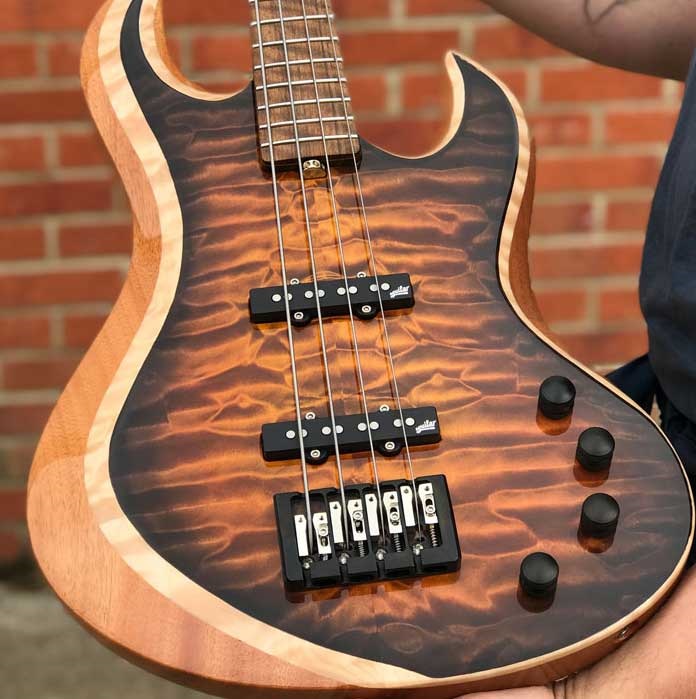(contributed by Robert Giovannetti of Vannetti Bass Designs and Best Bass Gear)
Gain is often misinterpreted to be synonymous with volume because they both sound like they mean the same thing, especially when referencing amplifier heads. Compound this with the fact that raising or lowering an instrument’s or amp’s gain will affect its volume, and it’s easy to see how the concept can be misunderstood.
What is gain? The power of an incoming signal. What is volume? The power of an outgoing signal, which includes the signal’s gain. You can think of it as gain being the strength of the signal and volume as the signal’s size.
Here are some illustrations to help in understanding this.


In the above example, the gain of the signal is illustrated by the thickness of the lines. Thicker = stronger signal = more gain while the volume is represented by their length. Longer = louder = more volume.


The signal is illustrated by the thin, short line above. Increasing the gain thickens the line, while boosting the volume lengthens it. The overall power (loudness) and quality of the signal is determined by the amount of both, and is why a low gain, high volume signal can sound just as loud as one with high gain, low volume; though not necessarily as “good.” I’ll discuss exactly why that is in the next article.
Do you have questions about gain and how it affects your bass tone? Ask your question by posting a comment below and we’ll do our best to answer.



This is an interesting explanation. In a practical sense, where I struggle with gain is in using effects that tend to give a sharp volume jump. I find that turning the gain down too much can take away from the effect, and can’t seem to find the right balance on certain pedals.
WELL ,,,THE WAY I SEE IT,,,CORRECT ME IF IAM WRONG HERE,,,,
ITS LIKE OPENING A WATER FORCET,,HOW MUCH WATER IS COMING THROUGH IS YOUR GAIN,,,HOW MUCH WATER YU NEED IS YOUR VOLUME,,,,
CLOSE???WHEN I PLAY LIVE OR ANYWHERE IT MATTERS,,MY GAIN MUST BE CLOSE TO FULL,,BECAUSE WHEN I NEED MY POWER TO MAKE A DIFFRENCE,,IT POWERS MY VOLUME WITH OUT PUSHING IT TO DISTORTION,,OH I PLAY BASS,,FENDER P-BASS,,66,,GREAT YEAR TOO,,THANKS GUYS AND GIRLS OUT THERE,,PEACE OUT
For me this kind of understanding gain is just a kind of not understanding, misunderstanding or even misleading for some kind of reason. talking about signal to noise ratio, frequency response and distortion in conjunction with gain (amplification) makes more sense to me.
This makes no sense to me at all. Volume is loudness and is measured in decibels. Gain is the difference between an input signal and an output signal. Maybe this article is trying to be signal strength for dummies but for anyone with an electronics background it’s just wrong (imho of course).
In this sentence, “You can think of it as gain being the strength of the signal and volume as the signal’s size” it sounds like you’re comparing current to voltage, or more specifically output impedance to voltage.
But OMG, I think I just figured out what you’re actually trying to explain. You’re talking about an amp head that has knobs labeled gain and volume? If that’s true it would be easier to just explain what a preamp and a power amp are and how they interact.
This is just plain wrong. Gain is the ratio of an output signal to the imput signal, and is synonymous with amplification. It is typically measured in dB (decibels).
In this context, the gain control varies the amplification of the preamplifier or input stage. This is provided to compensate for differing levels of input from pickups. The best signal to noise ratio is obtained by adjusting the gain control until the input signal just does not overdrive the preamplifier.
I’m sorry, but this is sheer nonsense. Gain is typically what the volume control is called on a pre-amp, volume is for the power amp, but either term could be used for either control. The only reason they are differentiated is because it would be confusing to have two knobs with the same name on the front panel. As someone else wrote, gain is strictly the ratio of the signal out over signal in, and that is exactly right, if there is no overdrive. On a transistor power amp, the volume control generally controls the maximum level signal from the preamp to the power amp and is usually designed to not allow the power amp to overdrive. On a valve amp, the power amp is usually allowed to overdrive and this is what gives the distinctive sound.
So on a transistor amp, the gain effectively controls how much over-drive you get, and the volume controls how loud the overall sound is. Thinking of it like that, you can see how the original author got it so wrong.